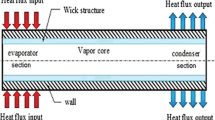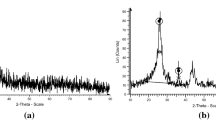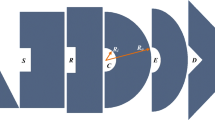Abstract
In this research, water–Fe3O4 nanofluid flow and heat transfer factors are optimized in a helically coiled pipe using Taguchi method. Numerical simulations using the ANSYS Fluent 18.2 are obtained first to provide the input data for the Taguchi method. Experiments are also performed to validate the results of the simulations. An experimental setup is constructed and initial experiments with water and water–Fe3O4 nanofluid are executed using various mass flow rates. A single-phase approach is employed as the numerical simulation model. The Taguchi method is selected as a test design method. Three different control factors (mass flow rate, coil curvature ratio and fluid type) with four levels are selected with the Taguchi method. An effective parameter, η, is defined to investigate the influence of different control parameters on heat transfer and fluid flow characteristics. Results show that mass flow rate is the most effective factor on η. Fluid type and the coil curvature ratio are next effective parameters, respectively. Through the course of this study, it is found that the best conditions to achieve the maximum η value are: mass flow rate value of 6.98 g s−1, 1% vol. nanofluid as fluid type and coil curvature ratio of 0.048.
















Similar content being viewed by others
Abbreviations
- A :
-
Area
- \(C_{\text{p}}\) :
-
Specific heat
- d, R :
-
Pipe diameter, pipe radius
- \(D_{\text{c}} ,a\) :
-
Coil diameter, coil radius
- f :
-
Friction factor
- \(\bar{h}\) :
-
Average heat transfer coefficient
- k :
-
Conductivity
- \(\dot{m}\) :
-
Mass flow rate
- Nu :
-
Nusselt number
- p :
-
Coil pitch
- \(q_{\text{s}}\) :
-
Heat transfer rate
- Re :
-
Reynolds number
- r :
-
Radial position
- T :
-
Temperature
- \(\vec{V}\) :
-
Velocity vector
- μ :
-
Dynamic viscosity
- υ :
-
Kinematic viscosity
- ρ :
-
Density
- φ :
-
Nanoparticles volume fraction in the base fluid
- \(\Delta T_{\text{lm}}\) :
-
Logarithmic temperature difference
- \(\Delta P\) :
-
Pressure drop
- η :
-
Dimensionless parameter for optimization
- δ :
-
Uncertainty
- bf:
-
Base fluid
- nf:
-
Nanofluid
- b, o:
-
Bulk, outlet
- b, i:
-
Bulk, inlet
- w:
-
Distilled water
- c:
-
Coil
- ave:
-
Average
References
Huminic G, Huminic A. Application of nanofluids in heat exchangers: a review. Renew Sustain Energy Rev. 2012;16(8):5625–38.
Wen D, Lin G, Vafaei S, Zhang K. Review of nanofluids for heat transfer applications. Particuology. 2009;7(2):141–50.
Rakhsha M, Akbaridoust F, Abbassi A, Majid S-A. Experimental and numerical investigations of turbulent forced convection flow of nano-fluid in helical coiled tubes at constant surface temperature. Powder Technol. 2015;283:178–89.
Suresh S, Chandrasekar M, Selvakumar P. Experimental studies on heat transfer and friction factor characteristics of CuO/water nanofluid under laminar flow in a helically dimpled tube. Heat Mass Transf. 2012;48(4):683–94.
Xin R, Ebadian M. The effects of Prandtl numbers on local and average convective heat transfer characteristics in helical pipes. J Heat Transf. 1997;119(3):467–73.
Huminic G, Huminic A. Heat transfer characteristics in double tube helical heat exchangers using nanofluids. Int J Heat Mass Transf. 2011;54(19–20):4280–7.
Manlapaz RL, Churchill SW. Fully developed laminar flow in a helically coiled tube of finite pitch. Chem Eng Commun. 1980;7(1–3):57–78.
Cioncolini A, Santini L. An experimental investigation regarding the laminar to turbulent flow transition in helically coiled pipes. Exp Therm Fluid Sci. 2006;30(4):367–80.
Zhu H, Han D, Meng Z, Wu D, Zhang C. Preparation and thermal conductivity of CuO nanofluid via a wet chemical method. Nanoscale Res Lett. 2011;6(1):181.
Yu W, France DM, Routbort JL, Choi SU. Review and comparison of nanofluid thermal conductivity and heat transfer enhancements. Heat Transf Eng. 2008;29(5):432–60.
Pang C, Jung J-Y, Kang YT. Thermal conductivity enhancement of Al2O3 nanofluids based on the mixtures of aqueous NaCl solution and CH3OH. Int J Heat Mass Transf. 2013;56(1–2):94–100.
A.I.A. AL-Musawi, A. Taheri, A. Farzanehnia, M. Sardarabadi, M. Passandideh-Fard. Numerical study of the effects of nanofluids and phase-change materials in photovoltaic thermal (PVT) systems. J Therm Anal Calorim. 2018. https://doi.org/10.1007/s10973-018-7972-6.
Goharkhah M, Ashjaee M, Shahabadi M. Experimental investigation on convective heat transfer and hydrodynamic characteristics of magnetite nanofluid under the influence of an alternating magnetic field. Int J Therm Sci. 2016;99:113–24.
Zonouzi SA, et al. Experimental investigation of the flow and heat transfer of magnetic nanofluid in a vertical tube in the presence of magnetic quadrupole field. Exp Therm Fluid Sci. 2018;91:155–65.
Akbaridoust F, Rakhsha M, Abbassi A, Saffar-Avval M. Experimental and numerical investigation of nanofluid heat transfer in helically coiled tubes at constant wall temperature using dispersion model. Int J Heat Mass Transf. 2013;58(1–2):480–91.
A. Safari, M. Saffar-Avval, E. Amani, Numerical investigation of turbulent forced convection flow of nano fluid in curved and helical pipe using four-equation model. Powder Technol. 2018;328:47–53.
Kotcioglu I, Cansiz A, Khalaji MN. Experimental investigation for optimization of design parameters in a rectangular duct with plate-fins heat exchanger by Taguchi method. Appl Therm Eng. 2013;50(1):604–13.
Hosseinzadeh M, Salari A, Sardarabadi M, Passandideh-Fard M. Optimization and parametric analysis of a nanofluid based photovoltaic thermal system: 3D numerical model with experimental validation. Energy Convers Manag. 2018;160:93–108.
Etghani MM, Baboli SAH. Numerical investigation and optimization of heat transfer and exergy loss in shell and helical tube heat exchanger. Appl Therm Eng. 2017;121:294–301.
A. Abadeh, M. Mohammadi, M. Passandideh-Fard. Experimental investigation on heat transfer enhancement for a ferrofluid in a helically coiled pipe under constant magnetic field. J Therm Anal Calorim. 2019;135(2):1069–79.
A. Abadeh, M. Passandideh-Fard, M.J. Maghrebi, M. Mohammadi. Stability and magnetization of Fe3O4/water nanofluid preparation characteristics using Taguchi method. J Therm Anal Calorim. 2019;135(2):1323–34.
J. Mohamoud, S. Tejvir. Critical review on nanofluids: preparation characterization and applications. J Nanomater.
Sundar LS, Singh MK, Sousa AC. Investigation of thermal conductivity and viscosity of Fe3O4 nanofluid for heat transfer applications. Int. Commun. Heat Mass Transf. 2013;44:7–14.
Maadi SR, Kolahan A, Passandideh-Fard M, Sardarabadi M, Moloudi R. Characterization of PVT systems equipped with nanofluids-based collector from entropy generation. Energy Convers Manag. 2017;150:515–31.
Akhavan-Behabadi M, Pakdaman MF, Ghazvini M. Experimental investigation on the convective heat transfer of nanofluid flow inside vertical helically coiled tubes under uniform wall temperature condition. Int Commun Heat Mass Transf. 2012;39(4):556–64.
Mahian O, et al. Recent advances in modeling and simulation of nanofluid flows-Part I: fundamentals and theory. Phys Rep. 2019;790:1–48.
Patankar SV, Pratap VS, Spalding DB. Prediction of laminar flow and heat transfer in helically coiled pipes. J Fluid Mech. 1974;62(3):117–29.
Liu Y, Wu R, Yang P, Wang T, Liu H, Wang L. Parameter study of the injection configuration in a zero boil-off hydrogen storage tank using orthogonal test design. Appl Therm Eng. 2016;109:283–94.
Wang H, Liu Y-W, Yang P, Wu R-J, He Y-L. Parametric study and optimization of H-type finned tube heat exchangers using Taguchi method. Appl Therm Eng. 2016;103:128–38.
Li Q, Xuan Y, Wang J. Experimental investigations on transport properties of magnetic fluids. Exp Therm Fluid Sci. 2005;30(2):109–16.
Bica D, Vekas L, Raşa M. Preparation and magnetic properties of concentrated magnetic fluids on alcohol and water carrier liquids. J Magn Magn Mater. 2002;252:10–2.
Wang X, Zhang C, Wang X, Gu H. The study on magnetite particles coated with bilayer surfactants. Appl Surf Sci. 2007;253(18):7516–21.
M. Ghobadi, Y.S. Muzychka. Fully developed heat transfer in mini scale coiled tubing for constant wall temperature. In: ASME 2013 International Mechanical Engineering Congress and Exposition. American Society of Mechanical Engineers; 2013. p. V08CT09A048.
R.K. Roy, A primer on the Taguchi method. Society of Manufacturing Engineers; 2010.
Farzanehnia A, Khatibi M, Sardarabadi M, Passandideh-Fard M. Experimental investigation of multiwall carbon nanotube/paraffin based heat sink for electronic device thermal management. Energy Convers Manag. 2019;179:314–25.
Sundar LS, Naik M, Sharma K, Singh M, Reddy TCS. Experimental investigation of forced convection heat transfer and friction factor in a tube with Fe3O4 magnetic nanofluid. Exp Therm Fluid Sci. 2012;37:65–71.
Author information
Authors and Affiliations
Corresponding author
Additional information
Publisher's Note
Springer Nature remains neutral with regard to jurisdictional claims in published maps and institutional affiliations.
Appendix: Uncertainty analysis
Appendix: Uncertainty analysis
In order to investigate the reliability of the measurements, an uncertainty analysis is performed for the experimental data [35]. The values of uncertainties estimated with different instruments are given in Table 7. The maximum possible error for the parameters involved in the analysis are estimated and summarized. For example, for calculating the absolute uncertainty of Nusselt number, the following relation is employed [36]:
and for the relative uncertainty:
Similarly, for other parameters, we have:
Table 8 presents the relative uncertainty of various parameters used in this research.
Rights and permissions
About this article
Cite this article
Mohammadi, M., Abadeh, A., Nemati-Farouji, R. et al. An optimization of heat transfer of nanofluid flow in a helically coiled pipe using Taguchi method. J Therm Anal Calorim 138, 1779–1792 (2019). https://doi.org/10.1007/s10973-019-08167-y
Received:
Accepted:
Published:
Issue Date:
DOI: https://doi.org/10.1007/s10973-019-08167-y




